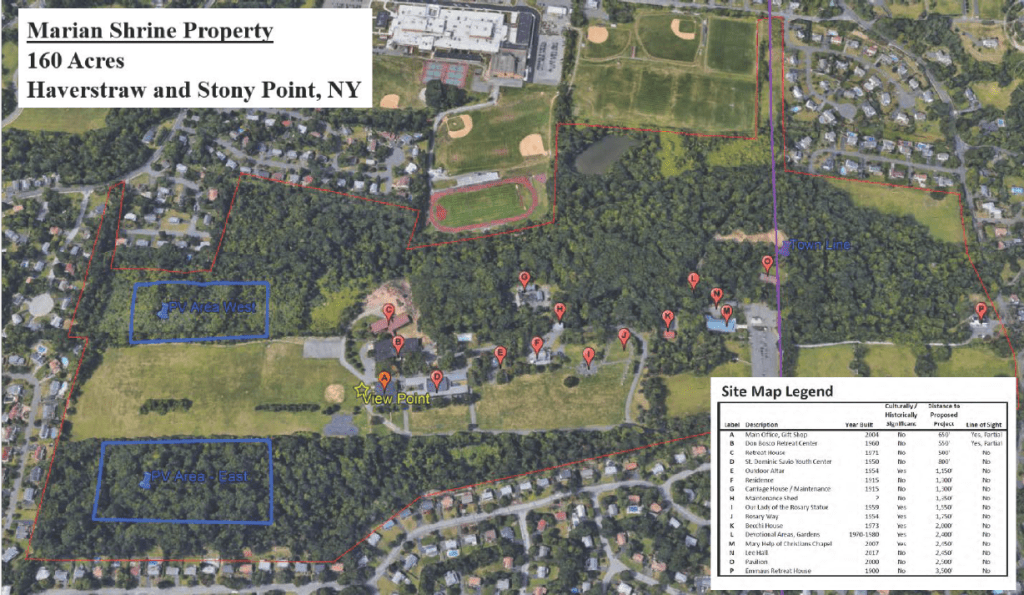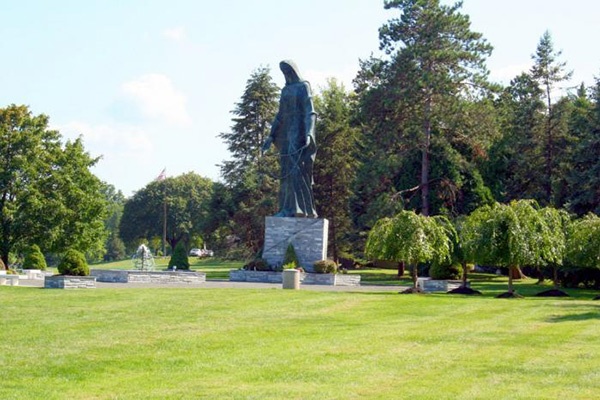|
RCBJ-Audible (Listen For Free)
|
The Proposal Requires Planning, Zoning & Town Board Approvals Before Clear-Cutting Woodlands For Installation Of Solar Panel Arrays
A proposal to clear-cut 13 acres of trees at the Marian Shrine in the Town of Haverstraw and replace it with a ground-mounted solar array is working its way through Haverstraw’s Planning, Zoning and Town Boards. The Planning Board, met with the applicant in January, and will consider the application again at a future meeting.
In addition to securing Planning Board approval, and a zoning variance, the applicant also needs to secure a Special Permit from the Town Board for the Marian Shrine site to operate as a “public utility substation.” The plan calls for carving off about 39 acres from the 160-acre retreat into a separate parcel. Those 39 acres would then be leased to Core Development Corporation of Mahwah, NJ. Core would clear-cut 13 acres of trees on the property and construct a 5-megawatt ground-mounted solar array that would feed its generated electricity directly into the Orange & Rockland (O&R) power grid.
Core Development Group is a renewable energy developer, contractor, and consultant that provides solar energy systems, battery storage, microgrids, and EV charging infrastructure to companies in the U.S. and abroad.
The area where the clear-cutting would occur is directly adjacent to open fields on the property and is heavily wooded hosting mature trees.
The Marian Shrine would receive monthly lease payments on the land and some other “undisclosed benefit,” according to the plan. Core Development sells the energy credits generated by the solar array to remote off-site third-parties, who would have those credits applied to their electric bills at discounted rates.
Access to the Marian Shrine is at 174 Pilors Lane in Stony Point, but the location of the subdivision and solar arrays are in the Town of Haverstraw. According to its website, “The Marian Shrine offers 160 acres of picturesque Holy Ground dedicated to Mary under the title, Help of Christians, St. John Bosco’s patroness and inspiration.”

In order to secure the necessary approvals, Core Development and the Salesian Society (owner of the Marian Shrine land) must convince the Town of Haverstraw Planning Board that its site plan complies with the town code, secure one variance from the ZBA for frontage on Suffern Place, and get approval from the Town Board for a Special Permit.
The plan presented to the Planning Board in January called for splitting the array into two footprints and siting them in a wooded area of the property. Thirteen acres of trees would need to be removed, and an installed power line would run to Suffern Place to connect with O&R’s existing infrastructure.
Town Code allows “Public Utility Substations” in the R-25 zoning district by Town Board Special Permit, provided they are “housed in buildings that harmonize with the character of the neighborhood and have adequate fencing, safety devices and screening.” Another condition of the Special Permit is that the facility “serve the area of the Town of Haverstraw and/or immediately adjacent communities.”
The proposal from Core Development and the Marian Shrine described the discounted electrical credits being issued to remote, off-site, third parties while also stating on the site plan that the “facility shall serve the Town of Haverstraw.” The Town Board will likely need to hash out this inconsistency and find out who will actually benefit from the energy credits generated by the solar arrays before it issues a Special Permit and as a condition of its issuance.
A spokesperson from Core Development responded by saying, “We are mindful that the zoning code regulations for this type of proposed development require that the facility serve the area of the Town of Haverstraw and/or immediately adjacent communities.”
Core Development Group’s says its proposed solar project would serve the local community in multiple ways: tax revenue to the Town; lease payments to Marian Shrine to help support its charitable mission; and, the creation of local jobs. Core Development also says that the financial credits must be applied to customers served by Orange & Rockland according to NYSERDA and Public Service Commission regulations, and that power generated from the project (which will power approximately 750 homes) will stay in the local area.
Under New York’s State Environmental Quality Review Act (SEQRA), a disturbance of more than 10 acres of land is generally considered a Type I action, and the Planning Board will need to make a determination about whether the proposed project may have a significant adverse environmental impact, and if it does, how to mitigate those impacts.
The Town of Haverstraw also codified the protection of live trees exceeding six inches in diameter at four feet above ground level and limits the conditions of their removal.
A review by the Rockland County Planning Department under the General Municipal Law states that while the County is “generally supporting of the development of renewable energy facilities in the County,” it urges the Town to “strongly consider the environmental sensitivity of this site, particularly the impacts associated with a large loss of trees and forested area.” The County Planner says, “Solar Development must not result in the overall degradation of the environmental quality of the Town, the County, and the region.”
The County recommends a carbon analysis to determine how the benefits of the proposed solar array compare with the loss of mature trees.
The Salesian Society would retain ownership of the land. The lease term to Core Development would be 30 years.











